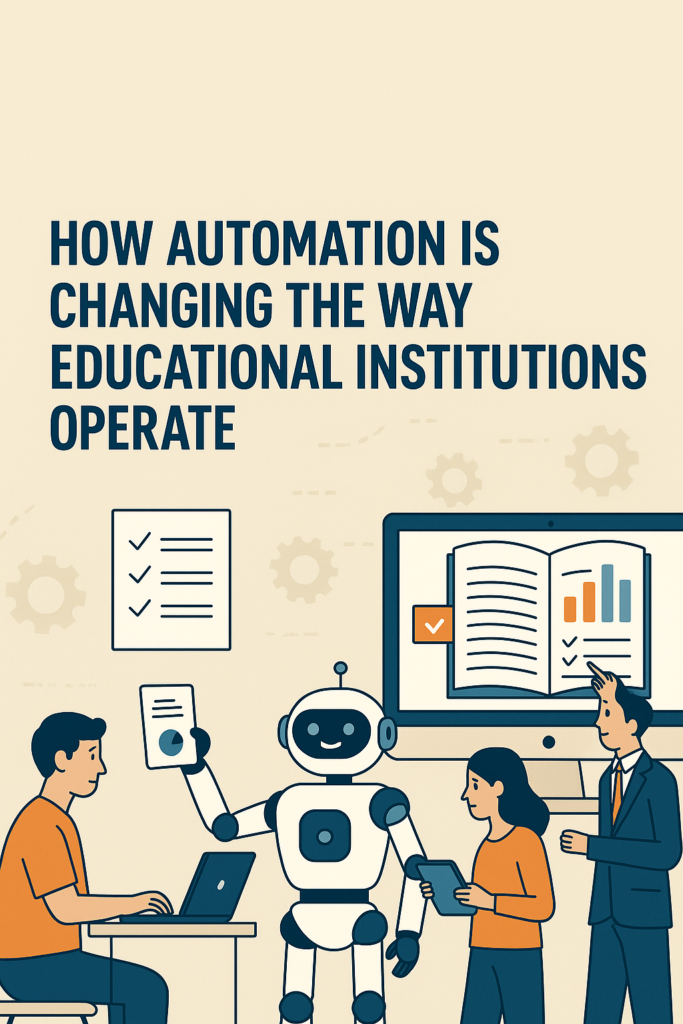The world of education is evolving faster than ever, and automation is quietly becoming the backbone of that transformation. From admissions to assessments, and from communication to compliance — educational institutions are embracing automation to make their operations smarter, faster, and more efficient.
In the past, running a college or university was heavily manual. Piles of paperwork, repetitive administrative tasks, and long queues for approvals or certificates were part of daily life. Today, with intelligent automation tools, much of that effort is being replaced by streamlined systems that let educators focus on what truly matters — teaching and learning.
1. Smarter Admissions and Enrollment Processes
The admission period used to be the most chaotic season in any educational institution — endless forms, verification delays, and manual data entry errors. Automation has simplified this entire process.
Now, digital application systems automatically capture student data, verify documents, send confirmation emails, and even schedule interviews or entrance tests — all with minimal human involvement.
This not only saves time for administrative teams but also enhances the experience for students who can complete their admissions from anywhere, anytime.
2. Automated Attendance and Academic Tracking
Attendance management has always been a repetitive but necessary task. With automated systems, attendance can now be recorded through biometric devices, facial recognition, or digital platforms linked to learning management systems (LMS).
But automation goes beyond marking presence — it tracks participation, punctuality, and even engagement levels. Teachers can instantly access insights about student performance, allowing them to identify who might need extra help or motivation.
This creates a more data-driven academic environment where decisions are made based on real progress rather than assumptions.
3. Streamlined Communication and Notifications
One of the biggest challenges in education management has been communication — ensuring that information flows smoothly between students, faculty, and administration.
Automation solves this by integrating messaging systems that send reminders, updates, and alerts automatically.
For instance, students get instant notifications about exam schedules, fee payments, or class changes. Faculty members receive automated reports or updates on their classes. Even parents can receive performance summaries without having to visit the campus.
It’s faster, clearer, and reduces the workload of staff who no longer have to manually draft and send dozens of messages every day.
4. Simplified Fee Management and Accounting
Finance departments in educational institutions often handle thousands of transactions every semester. Manual processing not only increases the risk of error but also delays reconciliation.
Automation brings transparency and efficiency here too.
Fee collection, receipts, refunds, and reminders can all be managed through automated payment gateways. Reports are generated in real-time, ensuring the finance team always has a clear view of revenue flow. This also improves accountability — every transaction is tracked digitally, leaving no room for discrepancies.
5. Enhanced Examination and Evaluation Systems
Automation has revolutionized how exams are conducted and evaluated. Online exam systems can automatically schedule tests, randomize question sets, and grade objective-type papers instantly.
Even for descriptive answers, AI-assisted tools help evaluators by highlighting key points or flagging inconsistencies. The result is a faster, fairer, and more transparent evaluation process.
Institutions benefit from reduced administrative strain, and students receive their results in record time — a win-win for both.
6. Data-Driven Decision Making
Automation isn’t just about doing things faster; it’s also about doing them smarter. Educational institutions generate vast amounts of data — attendance records, grades, financial data, student feedback, and more.
By automating data collection and analysis, administrators can uncover patterns and insights that were once hidden. For example, identifying which courses have higher drop-out rates, or understanding what factors influence student satisfaction.
With such information, institutions can make informed decisions to improve academic outcomes and operational efficiency simultaneously.
7. Empowering Educators and Students Alike
Automation doesn’t replace teachers — it supports them. Educators can automate repetitive tasks like grading quizzes, sending assignments, or tracking participation. This gives them more time to design engaging lessons, mentor students, and focus on real learning outcomes.
For students, automation offers greater control and flexibility. From registering for courses to accessing digital resources and submitting assignments, everything becomes more seamless. Learning is no longer limited by time or place — it’s a continuous, connected process.
8. Building a Future-Ready Institution
Automation is no longer optional — it’s essential. Educational institutions that embrace automation position themselves for long-term sustainability.
They attract more tech-savvy students, improve operational efficiency, and stay adaptable in an increasingly digital world. Whether it’s through AI-powered analytics, automated workflows, or cloud-based platforms, automation is redefining what it means to run a modern educational institution.
The transformation may not happen overnight, but the direction is clear: the future of education is efficient, data-driven, and deeply digital.
Conclusion
Automation is not about replacing people — it’s about empowering them. It takes away the routine, repetitive work and gives space for creativity, innovation, and human connection to thrive.
For Indian educational institutions, embracing automation isn’t just a technological upgrade — it’s a mindset shift toward a smarter, more responsive system that puts both learning and learners first.
The future campus isn’t one that runs on paper — it’s one that runs on intelligence.



